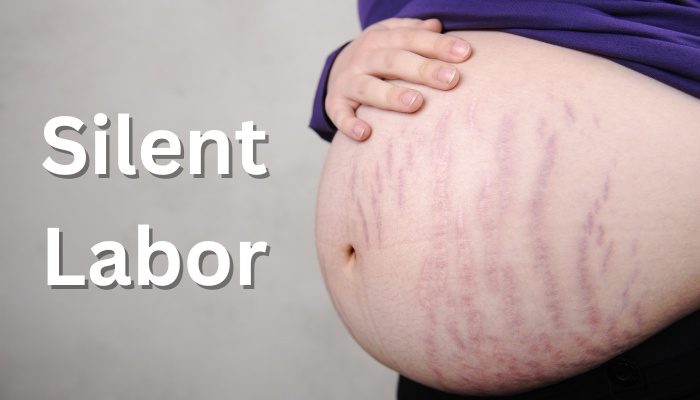Throughout their pregnancy, every expectant mother is constantly thinking about one thing: the health and well-being of their unborn child.
What will labor feel like, and what will be my experience?
The process of childbirth is typically associated with unmistakable signs, including regular contractions and intense pain, but, is it possible to be in labor and not know it?
There are instances where women can be in labor without realizing it. A phenomenon known as silent labor occurs when the typical symptoms and sensations associated with labor are absent or mild, leading women to be unaware of their progressing labor.
So, would that be a good thing or a bad thing? Who doesn’t want pain-free labor, right?! However, at the same time, it is important to know when you are in labor.
Let’s look a little deeper into silent labor, including what it is, why it happens, and how it can affect your labor experience.
What Is Silent Labor?
“Silent” or “unrecognized” labor is when a woman does not know that she is in labor.
In such cases, the mother does not experience any of the typical labor symptoms, such as regular contractions and noticeable pain, that are commonly associated with the onset of childbirth.
Silent labor typically refers to the early stages of labor as every woman will feel some degree of pain during the end stages of labor without pain medication or an epidural.
How Common Is Silent Labor?
It is important to note that silent labor is relatively rare. The majority of women experience labor symptoms, notable contractions, and pain as labor progresses.
Is Silent Labor Hereditary?
There is no evidence to suggest that silent labor is directly hereditary or that women can be predisposed to painless labor.
Silent labor is believed to be influenced by various factors, including individual pain perception, fetal position, and the strength and frequency of contractions.
While there may be a familial tendency for certain aspects of labor, such as the duration or progression of labor, there is no specific genetic marker or inheritance pattern associated with silent labor.
Each woman’s labor experience is unique and can be influenced by a combination of biological, environmental, and individual factors.
What Causes Silent Labor?
The exact causes of unrecognized labor are not fully understood, but there are several factors that could contribute to this phenomenon including:
- Individual pain perception and a higher pain threshold/tolerance.
- Fetal position: If the baby is in a position that puts less pressure on the cervix or nerve endings, the mother may not feel strong or consistent contractions.
- Irregular or mild labor contractions.
- Pain perception modulation: Women who experience silent labor may have different hormonal responses or psychological states that reduce their perception of pain.
What Does Silent Labor Feel Like?
While silent labor is characterized by a lack of typical labor symptoms or an absence of noticeable pain and contractions, there are likely other sensations that a woman feels.
Since silent labor varies from woman to woman, the experience may be subjective.
Some women may experience mild discomfort or sensations that are easily mistaken for other non-labor-related sensations including:
- Mild cramping
- Pressure or heaviness in the lower abdomen/pelvic region
- Backache
- Unusual sensations such as aching thighs or a feeling of rectal pressure

How Long Does Silent Labor Last?
Because silent labor refers to labor that goes unnoticed, it can be challenging to determine its exact duration.
Silent labor typically occurs during the early stages of labor, which can last anywhere from a few hours to a few days.
Silent labor is likely to eventually progress into active labor, during which the woman may begin to experience more noticeable signs and symptoms.
Is It Possible To Have Painless Labor Contractions?
There are stories of women whose bodies go into labor and do what needs to be done (i.e., contractions) without them feeling any pain at all.
While their labors are silent and painless in the beginning, the women often experience pain once active labor begins and their cervix begins to reach full dilation.
There is still no formal understanding of why this happens to some women; however, some researchers attribute it to being a carrier of a rare genetic variant that gives a woman a much higher threshold for pain.
When Do Pains Begin With Silent Labor?
Typically a “silent laborer” will begin to feel pain once active labor begins; however, this can vary from woman to woman.
Having Contractions but Not Feeling Them
Labor pains and contractions will feel different for every woman. Some women compare them to strong menstrual cramps.
Others may compare it to gas pains or indigestion. For some women, contractions may not feel like anything at all until they are really far along in the process.
Possible explanations for painless/unnoticeable contractions include:
- Weak contractions in the very early stage of labor.
- High pain tolerance.
It is also possible for a woman to experience contractions without feeling them when her uterus is irritable due to dehydration or a bladder infection. Such contractions may feel like indigestion or fetal movement.
Can You Be in Labor Without Contractions or Water Breaking?
Technically, no. Contractions always accompany labor as they are essential for getting the baby through the birth canal.
However, it is possible for a woman to be in labor and not feel her uterus contracting, or she may experience sporadic, mild contractions that are not easily noticeable.
Similarly, the rupture of the amniotic sac, or the water breaking, does not always occur at the beginning of labor. It may break later in the process or never break spontaneously.
These symptoms of silent labor can make it difficult to recognize the onset of labor.
When Does Your Water Break During Labor?
The timing of when a woman’s water breaks is unique and different from woman to woman. There is no set time of when a woman’s water will break or is supposed to break.
Some women’s amniotic sacs rupture early in the labor process while others rupture later.
For women with “intact membranes” whose water does not break spontaneously, a doctor must break their membranes.
Can You Dilate Without Knowing?
Absolutely. It is possible for a woman’s cervix to dilate in early labor without her knowing until she arrives at the hospital or is checked by her midwife.

Can You Dilate Without Contractions?
Dilation of the cervix is typically associated with contractions during labor. However, there are cases when cervical dilation can occur without noticeable or regular contractions.
This can happen during what is known as “latent” or “early” labor. During latent labor, the cervix begins to efface (thin out) and dilate in preparation for active labor.
In some women, this early phase of labor can be less intense and marked by irregular or mild contractions that may go unnoticed. However, the cervix can still gradually dilate and efface during this time.
It’s also important to note that the rate of cervical dilation during latent labor is generally slower than during active labor, where contractions become stronger and more regular.
In some cases, women may be dilating slowly over a period of hours or even days before entering active labor.
Its also worth mentioning that cervical dilation without contractions can occur in certain medical conditions such as cervical insufficiency or cervical incompetence.
These conditions can lead to premature dilation of the cervix without the presence of contractions, potentially increasing the risk of preterm birth.
How Far Can You Dilate Without Contractions?
It is difficult to determine an exact measurement of how far the cervix can dilate without contractions as it depends on various factors, including individual physiology, the position of the baby, and the progress of labor.
Typically during the early phase of labor, the cervix may dilate up to around 3-4 centimeters before transitioning to active labor.
It is possible for women to not feel these contractions during early labor; however, most women feel them during active labor.
Subtle Signs of Labor
There are early indicators that labor may be approaching or starting.
These signs may be more discreet and less intense compared to the classic signs of active labor, such as strong contractions and severe pain. Subtle signs can include:
- Lightening: The baby’s head may descend lower into the pelvis, relieving pressure on the diaphragm and causing the pregnant woman to feel like she can breathe more easily.
- Increased vaginal discharge: Discharge may be clear or slightly bloody. This discharge is known as the “bloody show” and is an early sign that the cervix is preparing for labor
- Changes in cervical mucus
- Backache and pelvic pressure
- Braxton Hicks contractions: These are practice contractions that may feel like mild tightening or squeezing sensations in the abdomen. They are typically irregular and do not increase in intensity or frequency.
- Nesting instinct: Some women may experience a burst of energy and an intense urge to prepare for the arrival of the baby
Closing Thoughts
In conclusion, while rare, silent labor is a real thing!
Even though the chances of you delivering without any pain or warning are slim to none, it is still absolutely essential to be aware and have regular prenatal checkups in order to ensure timely and appropriate care during childbirth.
Charlynn is an educator and mom to fraternal boy/girl twins. She loves learning through the experiences she has with her littles and using her knowledge to help other moms as they embark on the journey of motherhood.

